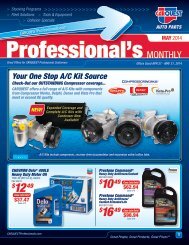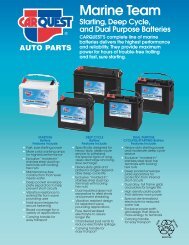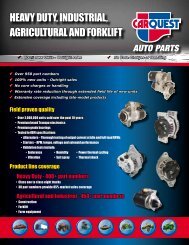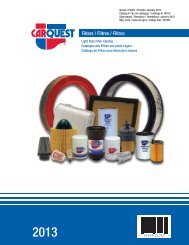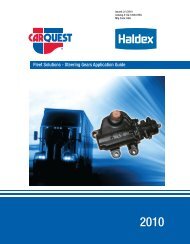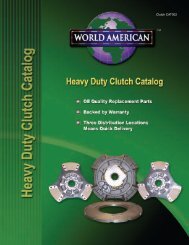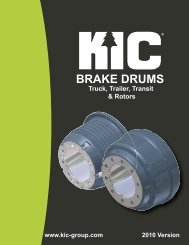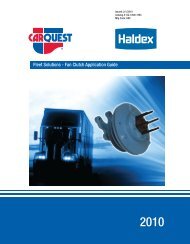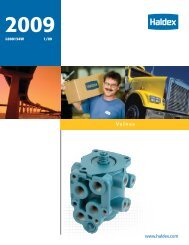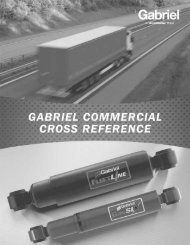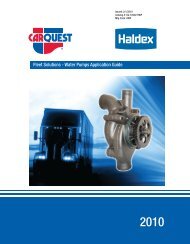Battery Application Guide - CARQUEST Auto Parts
Battery Application Guide - CARQUEST Auto Parts
Battery Application Guide - CARQUEST Auto Parts
- No tags were found...
Create successful ePaper yourself
Turn your PDF publications into a flip-book with our unique Google optimized e-Paper software.
BATTERY SAFETY<strong>Battery</strong> Replacement Data <strong>Application</strong> <strong>Guide</strong>DISCLAIMER: The battery replacement data published in this guide has been obtained from <strong>Battery</strong> Council International. The information contained in this guide was the most currentinformation available at the time of publication. The information is subject to change without notice from equipment manufacturers or field experience. Users should consult the mostcurrent edition of this application guide and their owner’s manual. The marketer and manufacturer expressly deny any responsibility for the accuracy provided. While every effort hasbeen made to accurately catalog the replacement battery information in this guide, any liability for damages as a consequence of using the information in this guide is expressly denied.Users should also attempt to obtain replacement battery data from the original equipment manufacturer’s user manual or service department for their specific application..PASSENGER CARS (1989 THROUGH 2010).The application data on the following pages is based on the manufacturer’s normal original equipment (O.E.) battery installation.It must be kept in mind that at the request of a larger user it is common in many 12-volt and 24-volt commercial systems to use6-volt batteries connected in series where 12-volt batteries are normally used. As a consequence, it is desirable to check theoriginal battery size and terminal arrangement before ordering. Also, some manufacturers will change battery sizes and terminalarrangements subject to availability at the time of manufacture or in the middle of a model year.If the battery or batteries to be replaced have terminal and/or cell arrangements different from the standard arrangement forthe battery size, be sure to specify exactly the arrangement desired. Also give complete details on all special sizes and/orterminal arrangements.As some batteries are still being marketed with Amp/Hrs. ratings, an approximate equivalent cranking performance value canbe obtained by taking 5-1/4 times the Amp/Hrs. rating..BATTERY RATINGS.COLD CRANKING AMPS @ 0°F (CCA)The primary function of the battery is to provide power to crank the engine during starting. This process requires a large dischargeof amperes over a short period of time. Therefore, the cold cranking performance (CCA) rating is defined as the discharge load inamperes which a new, fully charged battery at 0°F can deliver for 30 seconds and maintain a minimum voltage of 7.2 volts for a12-volt battery, 3.6 volts for a 6-volt battery. The cold cranking performance ratings listed in the application section of the guide arethe minimum recommendation for each application. There is no warranty level or battery life expectancy expressed or implied bythese ratings.CRANKING AMPS @ 32°F (CA) or MARINE CRANKING AMPS @ 32°F (MCA)The cranking performance rating is defined as the discharge load in amperes which a new, fully charged battery at a temperatureof 32°F can deliver for 30 seconds and maintain a minimum voltage of 7.2 volts for a 12-volt battery or 3.6 volts for a 6-volt battery.RESERVE CAPACITY (RC)Another function of the battery is to provide emergency power for ignition, lights, etc., in the event of failure of the vehicle’s batteryrecharging system. The reserve capacity rating is defined as the number of minutes a new, fully charged battery at 80°F can bedischarged at 25 amperes and maintain a minimum voltage of 10.5 volts for a 12-volt battery or 5.25 volts for a 6-volt battery..HEAT SHIELDS.Protective heat shields are being used around batteries with increasing frequency to protect them from premature failure due tohigh underhood temperatures. Failure to replace the heat shield after installation of a replacement battery may alter the fit, plusreduce its electrical performance and life..BEST FIT ESTIMATE.Some equipment manufacturers do not provide complete replacement battery information. In some cases replacement battery sizemust be estimated using the best information available to guide the battery replacement data guide user. However, the user iscautioned that the size stated is only an estimate. Size and terminal post arrangements may vary from the original equipment manufacturer.Therefore, the user should obtain specific battery replacement size information from the owner’s manual or from the dealeror equipment manufacturer. Caution should always be exercised to assure proper cable hook-up and sufficient post clearancebefore closing the hood or battery cover. Otherwise electrical system, and or vehicle damage, and/or personal injury could result..HOW TO USE THIS APPLICATION GUIDE.This guide is intended to help select the proper batteryor an alternate recommendation. The applicationsection lists the minimum cold cranking amps @ 0°Fand the recommended and optional replacementbattery part numbers. The manufacturers are listedalphabetically. For Passenger Cars, Light Trucks andVans, the applications are listed by year and enginesize. The remaining vehicles and equipment are listedby model and/or engine numbers. To assure the properreplacement battery:1. Find the correct manufacturer (make).2. Select the correct model or engine.3. Determine the year and/or model.4. Read across to the part number and, if applicable,an optional part number.5. Pay close attention to any footnoted information.If you are specifying a battery to a customer whodrives in extreme weather conditions and/or has avehicle with many electrical options, suggest a batterywith more cold cranking amps than the minimum thatis listed. Batteries with more cold cranking amps willnot harm the vehicle or equipment; however, batterieswith fewer cold cranking amps may fail prematurely.AC - Air ConditioningA-C - Allis ChalmersAlt. - AltitudeAT - <strong>Auto</strong>maticTransmissionBCI - <strong>Battery</strong> CouncilInternationalCalif. - Californiacarb. - carburetorCAT. - Caterpillarcc - cubic centimeterCA - Cranking Amps(32°F)CCA - Cold CrankingCFIA B B R E V I A T I O N S U S E D I N T H I S G U I D EAmps (0°F)- Central FuelInjectioncomp.-compressionCont. - ContinentalConv.- Convertiblecyl. - cylinderDD - Detroit DieselDES - Direct Electric StartDIN - German IndustryStandardDOHC-Dual Over Head CamEng. - Engineex. - exceptFed. - FederalFig. - FigureFl - Fuel InjectionFla. - FloridaFWD - Front Wheel DriveGM - General MotorsGSE - Gas Starting EngineGVW - Gross VehicleWeightHBL - Heated Back Light(rear windowdefrost)HD - Heavy DutyH.O. - High OutputHP - HorsepowerHSC - High SwirlCombustionHtd - HeatedHtr - HeaterIHC - InternationalHarvester Co.ind. - industrialInj. - InjectionJD - John DeereL - LiterLPG - LiquifiedPetroleum GasMFI - Multi-Port FuelInjectionMT - ManualTransmissionNo. - NumberO.E. - OriginalEquipmentOHC - Over Head CamOHV - Over Head Valveopt. - optionalPkg. - packagePS - Power SteeringPTO - Power Take OffRWD - Rear Wheel DriveS/C - SuperchargedSEO - SpecialElectrical OptionSHO - High OutputSOHC- Single Over HeadCamTBI - Throttle BodyInjectionV - Venturiw/ - withw/o - withoutWisc.- Wisconsin2WD - 2 Wheel Drive4WD - 4 Wheel Drive2



